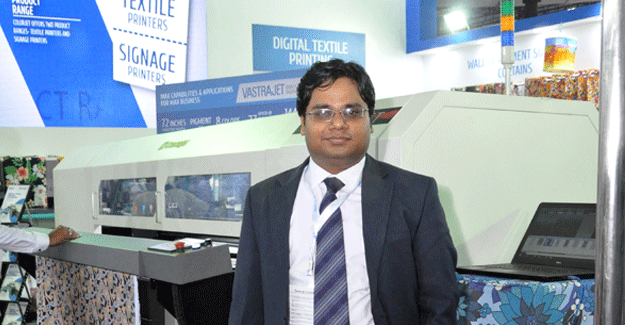Colorjet: Digital Textile Printing Is Economical, Environment-Friendly Technology
Colorjet: Digital Textile Printing Is Economical, Environment-Friendly Technology

How is the business for Colorjet?
Yes, we are getting enquiries from across India including the northern parts of India as well as South India, besides places like Surat and Ahmedabad in Gujarat. We have also received enquiries from Eastern India including Howrah and Kolkata.
What about international markets?
Talking about international markets, we received customers enquiries from Sri Lanka, Bangladesh and Dubai.
Digital textile printing technology in which Colorjet specialises in is relatively new. What are the advantages of this technology?
As you know, digital textile printing technology is different from conventional textile printing. It has several advantages over conventional textile printing processes. One main advantage is that the sampling process time in digital textile printing process is very less. The end user can do it within six hours to two days whereas in conventional textile process it takes a minimum of 20-30 days. The customer clearly gets an advantage in the sense that the time taken for sampling decreases.
In today's world, nobody wants to wait longer for samples and lead time matters. Everybody wants their orders to be executed in the shortest lead time possible. With traditional printing processes, executing orders so quickly is not possible.
The second advantage of digital textile printing is in the area of designs. Any kind of design can be printed - be it a vector design or a photographic design or anything which anybody could think of. Once again, this is impossible in conventional textile printing because of colour limitations and other factors. In conventional textile printing one can go for up to 16 colours, but in digital textile printing, there are eight pre-mixed colours from which one can get millions of colours and shades.
The textile industry is changing. Consumers are looking for innovative and fashionable colours or designs. They are looking for designs which are abstract,new, innovative, fresh and unique. Thirdly, I would say that in terms of environmental protection, conventional textile printing processes are very polluting and generate far more waste than digital textile printing. If a one square metre is printed using conventional printing ,it will consume about 100 litres of water but in digital textile printing the water consumption will be one tenth. That is a huge difference. So, digital textile printing is a greener technology.
How many digital printing machines have you installed so far? What's your installed base?
Our installed base is more than 70 machines. These have been installed at locations owned by customers and they are running successfully. Out of these, more than 30 machines have been installed in Surat alone. Major brands like Maspar, which is a home furnishing brand is using our machine. Our customers also export fabric printed over COLORJET machines, to countries like Australia and Canada.
Are you planning to launch any new variants or models of your machines?
We are constantly evolving and evaluating newer technologies. Our research and development team is working on some projects. In the next six months, we plan to introduce a couple of new models. We will be making a formal announcement in this regard like we always do.
What is it that drives customers to purchase your machines?
The key driver is that our machine is affordable even to a beginner. Even a small processing house which has just entered this industry or somebody just doing only job work can afford our machines.
Without compromising on quality, ColorJet has been able to offer competitive prices due to reasons like
1) ColorJet has adapted efficient Indian engineering and efficiently built their machines with the assurance that the customer gets a rugged and long-lasting technology
2) Many of the spares parts are manufactured indigenously without compromising on quality, thus saving cost and passing the benefit to customers. Many of the parts of the machine are handcrafted and provisioned, so the quality remains uncompromised.
3) Since the manufacturing is done in India, the company has the advantage of saving on labour and infrastructure cost, which are far lesser as compared to imported machines.
How does your research and development process function? Is it customer feedback driven?
Our research and development effort is a 360 degree process. It involves the end customer. We source feedback from operators who actually work on our machines. Our technical team is involved in this effort. Our sales team is also involved in finding out what are the features which customers want in their machines. We evaluate how we can incorporate these features into our machines. This is how we decide what features could be incorporated in our next models.



 textileexcellence
textileexcellence 







